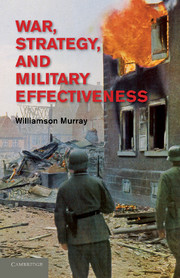Book contents
- Frontmatter
- Contents
- Introduction
- 1 History and the Future
- 2 Thucydides and Clausewitz
- 3 Clausewitz out, Computers in: Military Culture and Technological Hubris
- 4 Changing the Principles of War?
- 5 Military Culture Does Matter
- 6 History and Strategic Planning
- 7 Thoughts on Red Teaming
- 8 The Distant Framework of War
- 9 The Problem of German Military Effectiveness, 1900–1945
- 10 Reflections on the Combined Bomber Offensive
- 11 The Air War in the Gulf
- 12 Thoughts on British Intelligence in World War II and the Implications for Intelligence in the Twenty-First Century
- 13 The Meaning of World War II
- Index
- References
7 - Thoughts on Red Teaming
Published online by Cambridge University Press: 07 October 2011
- Frontmatter
- Contents
- Introduction
- 1 History and the Future
- 2 Thucydides and Clausewitz
- 3 Clausewitz out, Computers in: Military Culture and Technological Hubris
- 4 Changing the Principles of War?
- 5 Military Culture Does Matter
- 6 History and Strategic Planning
- 7 Thoughts on Red Teaming
- 8 The Distant Framework of War
- 9 The Problem of German Military Effectiveness, 1900–1945
- 10 Reflections on the Combined Bomber Offensive
- 11 The Air War in the Gulf
- 12 Thoughts on British Intelligence in World War II and the Implications for Intelligence in the Twenty-First Century
- 13 The Meaning of World War II
- Index
- References
Summary
In the twenty-first century, the United States and its allies will confront a number of disparate challenges. Enemies will prove adaptive and effective in preparing their military forces to attack, disturb, disorient, and prevent the projection of U.S. military power onto their territory and to deny the United States political and strategic victory. Moreover, they will undoubtedly fight within diverse strategic, operational, and tactical frameworks – frameworks largely determined by their societal, religious, and political cultures, all differing from those of the United States and its allies. America's potential opponents are already preparing to fight the U.S. military and, over the past decade, they have had two spectacular demonstrations of what its forces can do. The great difficulty for the armed forces of the United States lies in the fact that at present – and for the foreseeable future – they confront enormous ambiguity and uncertainty about their potential enemies; the conditions under which war will occur; as well as the staying power, military capabilities, and operational courses potential opponents might employ.
The question, then, that confronts the U.S. military is how to prepare forces to fight against opponents, the nature and aims of which are at present unclear. However much one might be tempted to prepare those forces on the basis of capabilities, such an approach will inevitably lead to mirror imaging. Thus, it would seem that red teaming U.S. forces and concepts from the highest to lowest levels represents the best alternative to learning on the battlefield, where military organizations learn by killing their own. This paper will use the term red teaming to mean the willingness to establish independent teams or other means to challenge the assumptions and preconceptions that military organizations often make. Such teams demand independent, perceptive officers and players unhindered by the strictures and mindsets of service cultures and bureaucratic restraints. War games, exercises, and maneuvers that prepare military forces for the future must involve red forces and red teams that can utilize asymmetric approaches, operational concepts, and tactics to challenge the plans and concepts of America's military. If they do not, they simply become one more method of validating the status quo, and historically the price paid for such an approach has been in blood and national treasure.
- Type
- Chapter
- Information
- War, Strategy, and Military Effectiveness , pp. 139 - 167Publisher: Cambridge University PressPrint publication year: 2011



